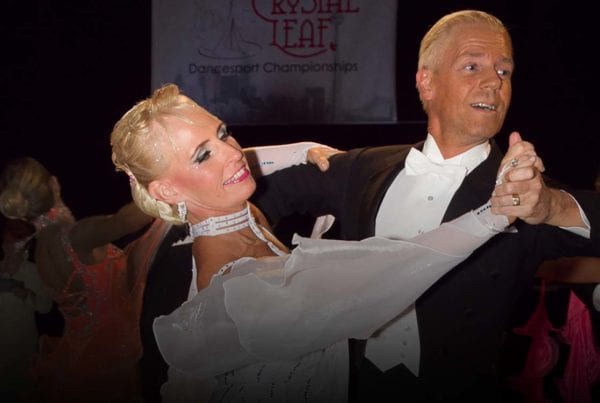Ballroom dancing is tough. Just watch top dancers from other styles, like those on the television show So You Think You Can Dance, when they try the ballroom dances.
Why? Because unlike other dance forms, ballroom dancing is especially designed around two people moving perfectly in sync to music. In other dance forms like Contemporary or Hip Hop, they will move in coordinated ways but it’s not exactly like what you have in ballroom dancing. In these other dances they are apart most of the time. Their feet will move together to the music, stepping together. They may have lines or lifts where they work together. But ballroom dancing, especially in the International Styles, requires them to move together seamlessly all the time. There is more forgiveness in the Latin genre, but even there many step patterns require an extraordinary level of consistent partnership.
So it’s no wonder that we have to deal with a lot of technique. Ballroom dancing is full of technical details. We take lessons for years. Even the teachers, myself included, continuously work on improving technique to enable us to move even more perfectly in sync with our partner. The better a ballroom dancer gets, the more effortless their movements look. When both members of the partnership are equally experienced, it can look like magic when they dance together, as if they are reading one another’s minds. This is the result of applying all the technical details, as each one contributes in a small way to the synchronized movement.
But of course, all this focus on technique can become a roadblock for some. We can get so caught up in the perfection of technique that we forget to dance. We get so busy thinking about the exact placement of each foot, the direction we’re facing, the angle of the body, the leading, the transfer of weight and other details that we are no longer dancing at all but just stepping around the floor with technical precision. That’s not dancing, and it’s no fun for your partner.
We call it analysis paralysis.
The picture above is a shot I took of a professional couple. I love this image because it’s a great illustration of the emotional power of ballroom dancing. Here are some tips to move your dancing from analysis paralysis to this kind of expressive experience.
Why do you dance?
The first step is to get back to the basics. Why do you dance? What motivated you in the first place? Motivation differs depending on your background and is usually very different for men than it is for women. But you need to keep reminding yourself why you’re here in the first place. That feeling which first led you to want to dance is the closest place to your heart and should be what you’re striving to achieve through the technical work you’re doing.
Remember that nobody’s perfect
Even the world champions make mistakes. Nobody is perfect. Dance is, by its very nature, an imperfect activity. How we respond to those things that don’t go the way we expect is part of the charm and beauty of ballroom dancing. The man leads a step or direction of movement. The lead may not have been perfect. The lady may misinterpret or misjudge. At that moment, he must be ready to respond to the variation. Done well, nobody will even know it didn’t go as expected, and in the perfect world, he enjoys the “imperfection” of that process even more than if it had all gone as planned. Take it as a challenge when your lead isn’t read the way you meant and you have to adapt on the fly. It’s fun and freeing and will expand your enjoyment of dance.
Focus
Another approach that can help you avoid analysis paralysis is to focus on one specific element as you dance and forget about all the others. For example, you might decide for a particular dance that all you’re going to work on is your forward progression. Apply yourself only to how you move to create more progressive movement from foot to foot, using your energy and the natural forces of body flight. Forget everything else! Really. Forget the footwork. Forget the rise and fall. Forget the straight vs. bent legs. Let those things take care of themselves for that dance, even when they go terribly wrong. In this way, you’ll start to let go of some of the technical thinking while still working on something.
Enjoy your partner
I’ve observed, especially among competitive dancers, that both men and women will often forget that they are dancing as a partnership. You can see it on their faces. They are so busy working on their own steps, their own technique, that the fact they are dancing with a beautiful person and sharing an experience designed to express togetherness is forgotten in the process. Enjoy the moment. Even in the Latin dances you are connected to a partner. Every step pattern, every movement, has a purpose and should be telling some kind of story about that partnership. For each step, ask yourself, what does my partner need from me to get more enjoyment out of this dancing experience? The more you give to your partner, the more both of you will enjoy dancing together. And when that happens, everyone around you will enjoy what they see from your partnership.
There’s a place for technical thinking. It’s during your lessons and technical practice time. But for each of these, you need to take opportunities to just dance while letting go of that focus on technique. Your dancing will improve dramatically if you can do this in between your technical practices.













I agree with your comments.Consider the following following analogy: An octopus performs ( always gracefully) with 8 appendages and one brain. A Dancesport couple should operate with one brain and 8 appendages ( 4 arms and 4 legs)- in synchronization gracefully.- that’s right one brain.
Dancing to me is movement generated by an emotion ( music is just one of multiple possible influences , eg happiness, anger or sadness etc etc.
To achieve this synchronization the couple must be very fit , strong and flexible as per WDSF training. WDC just wont hack it. You end up dancing like a clockwork couple- robot style. I believe and indeed practice cross training with ballet, TRX and Pilates and use the WDSF lectures as my guide. When I was a teenager I spent a lot of time figure skating and I still miss the euphoria of zooming across the ice to a Viennese waltz- the nearest thing you can get to flying. I try to imitate the feeling in a Viennese and also in a Foxtrot. I do envy the Octopus.
Harry Duerden. Gold Coast Australia.